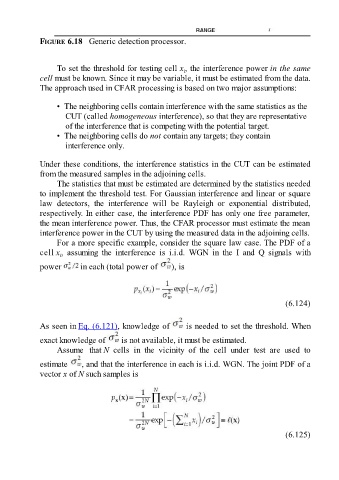Page 500 - Fundamentals of Radar Signal Processing
P. 500
FIGURE 6.18 Generic detection processor.
To set the threshold for testing cell x , the interference power in the same
i
cell must be known. Since it may be variable, it must be estimated from the data.
The approach used in CFAR processing is based on two major assumptions:
• The neighboring cells contain interference with the same statistics as the
CUT (called homogeneous interference), so that they are representative
of the interference that is competing with the potential target.
• The neighboring cells do not contain any targets; they contain
interference only.
Under these conditions, the interference statistics in the CUT can be estimated
from the measured samples in the adjoining cells.
The statistics that must be estimated are determined by the statistics needed
to implement the threshold test. For Gaussian interference and linear or square
law detectors, the interference will be Rayleigh or exponential distributed,
respectively. In either case, the interference PDF has only one free parameter,
the mean interference power. Thus, the CFAR processor must estimate the mean
interference power in the CUT by using the measured data in the adjoining cells.
For a more specific example, consider the square law case. The PDF of a
cell x , assuming the interference is i.i.d. WGN in the I and Q signals with
i
power in each (total power of ), is
(6.124)
As seen in Eq. (6.121), knowledge of is needed to set the threshold. When
exact knowledge of is not available, it must be estimated.
Assume that N cells in the vicinity of the cell under test are used to
estimate , and that the interference in each is i.i.d. WGN. The joint PDF of a
vector x of N such samples is
(6.125)

